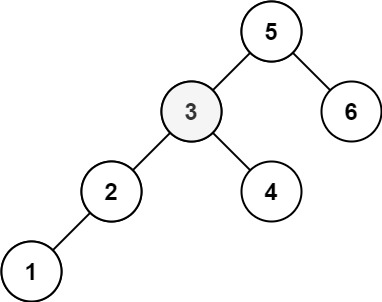Problem
Given the root of a binary search tree, and an integer k, return the kth smallest value (1-indexed) of all the values of the nodes in the tree.
Example 1:

Input: root = [3,1,4,null,2], k = 1 Output: 1
Example 2:

Input: root = [5,3,6,2,4,null,null,1], k = 3 Output: 3
Intuition
The task is to find the kth smallest value in a binary search tree (BST). In a BST, the left subtree of a node contains only nodes with smaller values, and the right subtree contains only nodes with larger values. Therefore, performing an in-order traversal of the BST will visit the nodes in ascending order. The intuition is to use an iterative in-order traversal (using a stack) and stop when the kth smallest element is encountered.
Approach
Initialization:
Initialize a variable n to count the number of visited nodes.
Initialize an empty stack to perform the iterative in-order traversal.
Start with the root node as the current node (cur).
Iterative In-Order Traversal:
While cur is not None or the stack is not empty:
Push all left children of cur onto the stack until reaching the leftmost node.
Pop a node from the stack (represents the current node in in-order traversal).
Increment the count n by 1.
If n is equal to k, return the value of the current node.
Move to the right child of the current node (cur = cur.right).
Return Result:
Return the kth smallest value found during the traversal.
Complexity
- Time complexity:
The time complexity is O(n), where n is the number of nodes in the binary search tree. In the worst case, the algorithm visits all nodes in the tree during the in-order traversal.
- Space complexity:
The space complexity is O(h), where h is the height of the binary search tree. This is because the maximum depth of the stack is equal to the height of the tree. In the average case, for a balanced binary tree, the height is O(log n), making the space complexity O(log n). However, in the worst case of an unbalanced tree, the height could be O(n), resulting in a space complexity of O(n). The space complexity is dominated by the depth of the stack during the traversal.
Code
# Definition for a binary tree node.
# class TreeNode:
# def __init__(self, val=0, left=None, right=None):
# self.val = val
# self.left = left
# self.right = right
class Solution:
def kthSmallest(self, root: Optional[TreeNode], k: int) -> int:
n = 0
stack = []
cur = root
while cur or stack:
while cur:
stack.append(cur)
cur = cur.left
cur = stack.pop()
n += 1
if n == k:
return cur.val
cur = cur.right























 428
428

 被折叠的 条评论
为什么被折叠?
被折叠的 条评论
为什么被折叠?








